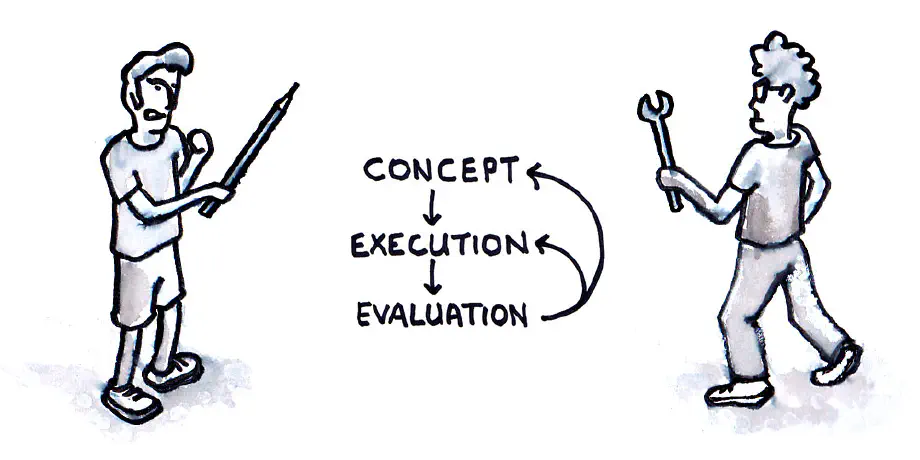We often think of design as merely the practice of applying aesthetically pleasing details, often unnecessary, to functional things. This is probably both a consequence of advertising forcibly associating the term with the dream of lifestyle (John Berger / Ways of Seeing , Episode 4, 1972) and engineers (architects often included) who tend to forget that engineering1 is about designing solutions.
I’d argue that in daily talk, people stick to very close-minded interpretations. Even calling oneself a designer can be considered a faux pas, for again the term sounds way too vague in our age of specialization. Hence the reassuring epithets such as graphic; industrial; User eXperience; fashion; architectural2 and so forth.
Design is about making something easy to use, or easy to understand.
We may have become so accustomed to binary logic, that we tend to visualize designers and engineers at the different ends of a usability spectrum. Those familiar with web-design will recognize a similar pattern in the supposed designer / developer split. Design is about experiences. Engineering is about solutions. Design differs from engineering in where the first strives to be experience-oriented, the second is fine with being result-oriented. However both design and engineering are the fundamental nodes in any creative process. The designer plans a solution based on assumptions and previous knowledge then the engineer develops a solution by applying said knowledge then testing and iterations follows. This isn’t much different from the hypothesis & experiment flow modern Science is based on. What becomes apparent is that designer and engineer are intertwined, non-exclusive roles.

When undertaking the role of consumer, we may not always be aware of the aforementioned model, but we seem to instinctively assume3 that objects around us are results of such previously mentioned testing and iteration use. Keeping in mind that design isn’t about nice typefaces and pretty illustrations, this bias can be vividly seen in cheap food delivery leaflets: bad design attracts more bad design as the public becomes familiar with it.
What is more, designers are not oblivious to this mental barrier. They also tend to get fixated (David G. Jansson and Steven M. Smith, Design fixation [PDF]) on previous solutions (not limited to others’) and thus hinder their own capacity for innovative problem solving.
Design fixation, which may be attributed to the lack of movement between the two spaces (concept and configuration), thereby inhibiting the innovative abilities of design engineers. This may be observed when a designer produces a final design which almost mirrors his or her initially conceived idea because of a rigid cognitive adherence.
— David G. Jansson et al., Cognition in design: viewing the hidden side of the design process.
Research appears to validate the old imperative for creatives: “do not get overly attached to your creations”.
A designer needs to avoid the consumer-role traps and always question current practices. Just because someone did it before, doesn’t mean their solution is intrinsically good, not even if that solution seems popular to their audience. Choosing a known pattern over something innovative yet unfamiliar needs to be a conscious choice.
So if we focus on those tiny details, the ones we may not see and we look at them as we say, “Are those important or is that the way we’ve always done it? Maybe there’s a way to get rid of those.”
The takeaway is that in order to keep an open mind, designers need to scrutinize common solutions to common problems and take for granted as few things as they can. It wouldn’t be far-fetched to suggest that Tony Fadell’s argument could very well become a mantra towards self-improvement. We owe to ourselves to always question whether our preferences —and thus choices— are conscious decisions or automatic repetitions4 of things we’ve grown accustomed to.
“[T]he creative application of scientific principles to design or develop structures, machines, apparatus, or manufacturing processes, or works utilizing them singly or in combination; or to construct or operate the same with full cognizance of their design; or to forecast their behaviour under specific operating conditions; all as respects an intended function, economics of operation and safety to life and property.” — American Engineers Council for Professional Development (1941) ↩︎
A tongue-in-cheek mention: It is amusing to see how architects shy away from labeling themselves as designers. However, I’m personally akin to the definition of architecture as the extended science of space, which indeed mainly manifests through the theoretical and pragmatic design of structures. ↩︎
Citation required. ↩︎
A 2006 Duke University study (PDF) showed that more than 40% of the actions we perform every day are driven by habit. That’s right: nearly half of what you do every day is automatic, unconscious. — Dina Chaiffetz, How to build habit-forming products ↩︎